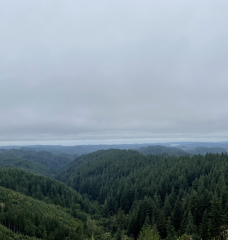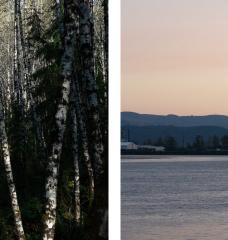
This story by MIT Environmental Solutions Journalism Fellow Alex Baumhardt was originally published in the Oregon Capital Chronicle, where it appears with additional photos and resources.
No man-made machine on Earth can better capture planet-warming carbon dioxide from our atmosphere than a healthy forest.
And the most effective carbon-storing forests in the world are the wet, dense, giant conifer forests of the Northwest. The forests in Oregon’s Coast Range absorb and store more carbon per acre than almost any other forests in the world – including the Amazon Rainforest.
For more than a century, these forests have been heavily logged, supporting a vast timber industry worth billions of dollars. But, companies behind a new and growing market force are hoping to bank on the money-making potential of Oregon forests that are left intact, doing what they’ve always done: absorb and store carbon in their bark, tissue, leaves and needles and in the soil beneath them. In doing so, they help combat the growing threat of climate change.
Just a few years before Julie and John Christensen bought their 70-acre forest in Corbett, it had been clear-cut for logging and for animal grazing. So, they planted thousands of trees, making it a sanctuary to the bears, cougars and deer navigating a broader landscape taxed by growing logging and development.
Hoping to preserve their reforestation efforts, they signed a contract in 2023 with the company Forest Carbon Works that binds the future of their forest to a voluntary carbon crediting market.
If even 20% of existing family-owned, private forest acreage in the U.S. like that owned by the Christensens – about 50 million acres – was enrolled in carbon markets that necessitate better management and lighter logging, family forests could trap up to 1 billion additional tons of planet-warming carbon dioxide in the next 30 years, according to an analysis from the nonprofits American Forests Forever and The Nature Conservancy. That’s about equal to taking all cars off of U.S. roads for one year.
The extraordinary costs of climate change hit home for Cody Desautel during the 2015 wildfire season. Now executive director of the Confederated Tribes of the Colville Indian Reservation, he watched hundreds of thousands of acres of forests burn – forests that were about to be entered into California’s carbon offset market, where tribal-owned forests have become the workhorses of the state-regulated emissions reduction program.
For Desautel and other tribal leaders, carbon markets are a way for corporations responsible for environmental degradation to reward and protect Indigenous forest management practices that have historically been less extractive. Desautel saw it as a way for his tribe, in one of the poorest corners of Washington, to generate revenue on the back of a promise that few industrial forest owners today are willing to make: ensure that above all other interests, especially logging, forests keep providing the air-cleaning, water-filtering, habitat-supporting work they’ve done for free, forever.
When the Astoria City Council got the results of a forest inventory in the Bear Creek Watershed about a decade ago, councilors learned the city was in possession of far more valuable trees, and timber, than they had realized.
Some council members wanted to reap the extra dollars by logging it but others were concerned that it had been over-logged in the past and wanted to preserve it. They decided to call a carbon project developer, to see whether there was a way to make some money off their newfound tree inventory without increasing harvests. It’s a decision that a small but growing number of public landowners and managers in the state are making: scale back logging, and attempt to offset some of the lost timber revenue with revenue from the sale of carbon credits earned by keeping the forest intact.





